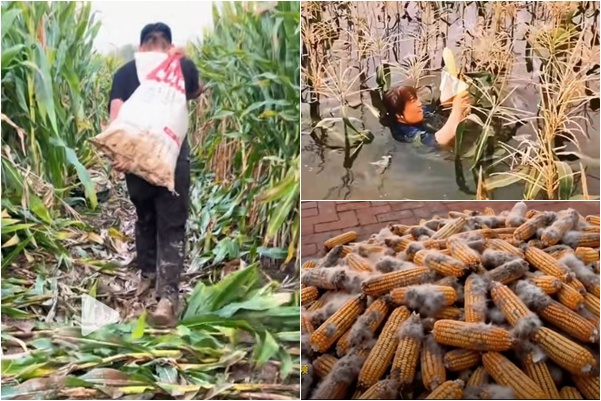In some parts of the Huanghuaihai region in mainland China, continuous autumn rains have been falling since September, causing fields to become waterlogged during the critical period of autumn harvest. Due to the delayed harvest and moldy corn, prices have plummeted. In order to dry the corn, the drying machines of XCMG have sold out.
According to a report from Economic Observer, on October 16th, Chen Xingyu, a farmer in Shangqiu, Henan, stood knee-deep in mud, breaking corn cobs, many of which had developed mold. Most of his over ten mu of cornfields were waterlogged, with the deepest parts reaching his knees. Chen Xingyu estimates that the mold rate of his corn this year is close to 70%.
The moldy corn directly impacts the purchase price. According to reports, a grain purchaser in Zhoukou, Henan, revealed that the purchase price for moldy corn is currently only between 0.2-0.3 yuan per kilogram. For corn of even poorer quality with mold, the purchase price is expected to further decrease. Whereas during the same period last year, corn prices varied in different regions but were generally between 1.05-1.15 yuan per kilogram.
Chen Xingyu calculated the costs – 80 yuan for corn seeds per mu, 150 yuan for fertilizer per bag, 30 yuan for machine seeding, 120 yuan for track harvester, and 30 yuan for transportation from the field to home, not including labor costs. With the poor corn yield this year, only when prices exceed 60 cents per kilogram can he break even.
According to China Weather Net, since September 2025, there has been a significant increase in rainfall in many parts of northern China compared to the same period in previous years. Among them, Shandong, Henan, and other areas have recorded the highest cumulative rainfall in history. Mountain Trigger Town, Tunliu District, Shanxi, did grain business, and Qiao Qiang said the rainfall this year was the first time he had seen in over 40 years.
Meteorological authorities predict that due to the prolonged rainy weather, the summer corn harvest in the Huanghuaihai region will be delayed, causing tight crop rotations and making it difficult to till the soil due to high soil moisture content, leading to adverse effects on winter wheat production.
A video on a social media platform shows a farmer explaining that by late September in previous years, autumn corn had been harvested and winter wheat planted. However, this agricultural cycle has been disrupted by continuous rainfall this year. The ongoing rain has led to corn mold, with many mature corn cobs feeling soft to the touch, and even the cores showing signs of rot. Farmers are worried as the soil moisture content remains high, and weather forecasts indicate possible further rainfall, putting the planting of winter wheat in doubt.
Reportedly affected areas this autumn due to the rain mainly focus on Huanghuaihai region – Hebei, Henan, Shandong, Hubei, Anhui, Jiangsu, as well as Shanxi, Shaanxi, Gansu, and other major grain-producing provinces.
The continuous autumn rain causing corn to mold in the fields has compelled farmers to use grain drying machines to salvage the harvest. This led to a shortage in the supply of XCMG’s grain drying machines.
Economic Observer reported that this leading equipment manufacturing company responded to this year’s autumn rain by holding a supply assurance meeting, wherein they decided to double their workers, increasing daily production from 15 machines to 30 machines. However, despite the increased production, the orders keep pouring in, putting immense pressure on deliveries, with machines being immediately dispatched from the production line without holding inventory.
Another leading company, Anhui Zhengyang Technology, has seen a 40% year-on-year increase in sales of grain drying machines. The sales manager has been travelling across multiple northern provinces, departing from Lu’an, Anhui to Beijing on October 12th, with only rain or heavy rain throughout the journey.
Liu Yan (pseudonym), who sells drying machines in southern Henan, hasn’t had a proper night’s sleep in over ten days. She shuttles between various drying centers each day and receives continuous inquiries about purchasing and installing drying machines.
At customers’ places, Liu Yan noticed rice that couldn’t be air-dried had sprouted and emitted a sour smell, while peanuts soaked in the ground, with many farmers giving up.
The buyers of drying machines are mainly grain purchasers or large-scale growers, who rely on drying machines to set up grain drying centers called by the government. Liu Yan observed that many large-scale growers were transporting rice to drying centers for drying, but “the drying machine capacity is still insufficient.”
Bu Zhenkui from Bulo Village, Jiu Nvji Town, Chengwu County, Shandong, mentioned that his drying machine can process up to 40 tons at a time and, according to this year’s harvest conditions, can handle nearly 100 mu of corn in one go. Since September 28th, his drying machine has been running 24 hours a day, but there are still many farmers queuing up. “Even with three more drying machines, they would still be busy.”
Qiao Qiang, who has been in the grain business for seven years, is as busy as Bu Zhenkui. He said, “Our drying machines operate 24 hours a day, with seven people working in shifts. I sleep for only 2-3 hours a day. Last year, we could rest when tired, but not this year. We don’t look at the weather or time.”
In July, Qiao Qiang installed two drying machines early based on agricultural proverbs. “As the saying goes, ‘Spring winds, autumn rains; the stronger the wind in spring, the heavier the rain in autumn.’ This year’s farming proverb is ‘Seven dragons control water, four cattle plow the land, nine people share the cake,’ meaning that crops will reduce due to climate effects.” Qiao Qiang finds these agricultural proverbs very useful, but many farmers no longer understand them.

